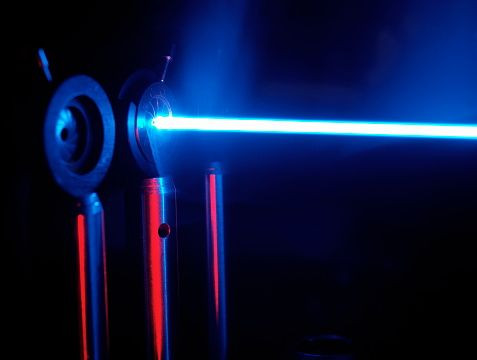New Light Form Proves 3 Photons Can Interact, Could Help Quantum Computing

Photons, the constituent particles of light, normally have no mass and don’t interact with each other, passing each other by when put in each other’s paths. But an experiment by a team of scientists from Massachusetts Institute of Technology (MIT) and Harvard University has shown that photons can bind together in twos or threes, proof of interaction between them.
Led by Vladan Vuletic from MIT and Mikhail Lukin from Harvard, the researchers conducted experiments with lasers and ultracold rubidium atoms. A weak laser beam was shone through a dense cloud of the ultracold atoms, and what emerged from the other side were photons bound in pairs or triplets — a completely new form of photonic matter.
This interaction between photos was attraction, and the bound photons were also found to have acquired some mass (just a fraction of an electron’s mass). This new-found mass literally weighed down the photons, slowing them down from their usual speeds of 300,000 kilometers per second (the same as the speed of light) by about 100,000 times.
“The interaction of individual photons has been a very long dream for decades,” Vuletic said in a statement Thursday, explaining that the attraction — or entanglement — of photons could herald a significant development for the future of quantum computing.
“Photons can travel very fast over long distances, and people have been using light to transmit information, such as in optical fibers. If photons can influence one another, then if you can entangle these photons, and we’ve done that, you can use them to distribute quantum information in an interesting and useful way,” Vuletic said.
Vuletic and Lukin have previously conducted experiments in which they observed photons binding in pairs, and the new experiments were designed to see if they could get more than two photons to interact at the same time.
To explain the physics behind the photon interactions, the researchers came up with the following hypothesis: “As a single photon moves through the cloud of rubidium atoms, it briefly lands on a nearby atom before skipping to another atom, like a bee flitting between flowers, until it reaches the other end. If another photon is simultaneously traveling through the cloud, it can also spend some time on a rubidium atom, forming a polariton — a hybrid that is part photon, part atom. Then two polaritons can interact with each other via their atomic component. At the edge of the cloud, the atoms remain where they are, while the photons exit, still bound together. The researchers found that this same phenomenon can occur with three photons, forming an even stronger bond than the interactions between two photons.”
Since the photons remain linked even after they are out of the cloud of ultracold rubidium atoms, they can be considered to be strongly correlated, or entangled — making them a potential candidate for a quantum computing bit, or a qubit.
Using ultracold atoms, Lukin’s team had built a 51-qubit quantum computer, which was announced in July 2017.
The new paper, titled “Observation of three-photon bound states in a quantum nonlinear medium,” appeared online Friday in the journal Science.
© Copyright IBTimes 2024. All rights reserved.




















